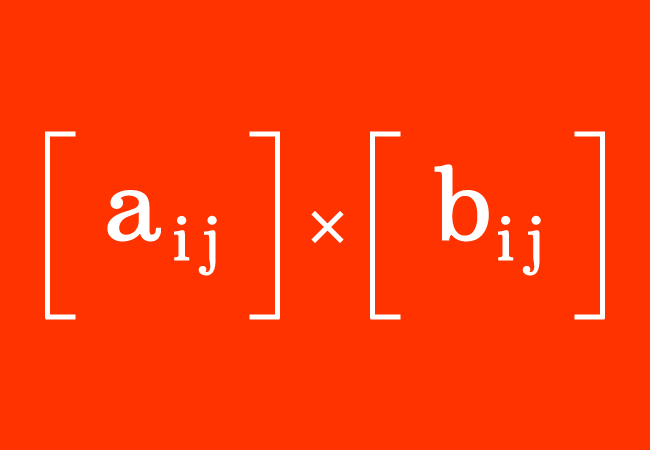A mathematical operation of multiplying a matrix by another matrix is called the multiplication of the matrices.
In matrices, the entries (or elements) are arranged in rows and columns. It confuses us how to multiply two or more matrices mathematically when the matrices participate in multiplication. However, there is a systematic procedure for multiplying the matrices. So, let’s learn how to multiply the matrices in mathematics.

The multiplication of the matrices is possible if the total number of elements in a row of the first matrix is equal to the total number of entries in a column of the second matrix.
$A \,=\, \big[a_{ij}\big]_{m \times r}$ and $B \,=\, \big[b_{ij}\big]_{r \times n}$
$A$ and $B$ are two matrices. The matrix $A$ is a matrix of the order $m \times r$ and the matrix $B$ is a matrix of the order $r \times n$. The $a_{ij}$ and $b_{ij}$ represent each entry in the matrices $A$ and $B$ respectively. Here, $i$ and $j$ represent “the number of the row” and “the number of the column” of the element.
The multiplication of the matrices is written in mathematics as follows.
$\implies$ $A \times B$ $\,=\,$ $\big[a_{ij}\big]_{m \times r}$ $\times$ $\big[b_{ij}\big]_{r \times n}$
Let’s assume that C is a matrix, which represents the product of the matrices $A$ and $B$.
$\,\,\,\therefore\,\,\,\,\,\,$ $C$ $\,=\,$ $\big[c_{ij}\big]_{m \times n}$
The number of rows in the matrix $C$ is equal to the number of the rows of the matrix $A$. Similarly, the number of columns in the matrix $C$ is equal to the number of the columns of the matrix $B$. Hence, the product of the matrices $A$ and $B$ is the matrix $C$ of the order $m \times n$.
This algebraic analysis can be understood much clear in the below examples section.
There are two simple steps for multiplying the matrices in mathematics.
Let’s learn how to multiply the matrices from the following two examples.
$(1).\,\,\,$ ${\begin{bmatrix} 1 & 2 \\ 3 & 4 \\ \end{bmatrix}}$ $\times$ ${\begin{bmatrix} 5 & 6 \\ 7 & 8 \\ \end{bmatrix}}$
$\implies$ $\begin{bmatrix} 1 & 2 \\ 3 & 4 \\ \end{bmatrix}$ $\times$ $\begin{bmatrix} 5 & 6 \\ 7 & 8 \\ \end{bmatrix}$ $\,=\,$ $\begin{bmatrix} 1 \times 5+2 \times 7 & 1 \times 6+2 \times 8 \\ 3 \times 5+4 \times 7 & 3 \times 6+4 \times 8 \\ \end{bmatrix}$ $\,=\,$ $\begin{bmatrix} 5+14 & 6+16 \\ 15+28 & 18+32 \\ \end{bmatrix}$
$\,\,\,\therefore\,\,\,\,\,\,$ $\begin{bmatrix} 1 & 2 \\ 3 & 4 \\ \end{bmatrix}$ $\times$ $\begin{bmatrix} 5 & 6 \\ 7 & 8 \\ \end{bmatrix}$ $\,=\,$ $\begin{bmatrix} 19 & 22 \\ 43 & 50 \\ \end{bmatrix}$
The order of each multiplying matrix is $2$ in this example. Hence, the order of their product matrix is also $2 \times 2$.
$(2).\,\,\,$ ${\begin{bmatrix} 1 & 2 & 3 \\ \end{bmatrix}}$ $\times$ ${\begin{bmatrix} 4 & 5 \\ 6 & 7 \\ 8 & 9 \\ \end{bmatrix}}$
$\implies$ ${\begin{bmatrix} 1 & 2 & 3 \\ \end{bmatrix}}$ $\times$ ${\begin{bmatrix} 4 & 5 \\ 6 & 7 \\ 8 & 9 \\ \end{bmatrix}}$ $\,=\,$ ${\begin{bmatrix} 1 \times 4+2 \times 6+3 \times 8 & 1 \times 5+2 \times 7+3 \times 9\\ \end{bmatrix}}$
$\implies$ ${\begin{bmatrix} 1 & 2 & 3 \\ \end{bmatrix}}$ $\times$ ${\begin{bmatrix} 4 & 5 \\ 6 & 7 \\ 8 & 9 \\ \end{bmatrix}}$ $\,=\,$ ${\begin{bmatrix} 4+12+24 & 5+14+27\\ \end{bmatrix}}$
$\,\,\,\therefore\,\,\,\,\,\,$ ${\begin{bmatrix} 1 & 2 & 3 \\ \end{bmatrix}}$ $\times$ ${\begin{bmatrix} 4 & 5 \\ 6 & 7 \\ 8 & 9 \\ \end{bmatrix}}$ $\,=\,$ ${\begin{bmatrix} 40 & 46\\ \end{bmatrix}}$
The order of the first matrix is $1 \times 3$ and the order of the second matrix is $3 \times 2$. Hence, the order of their product matrix is $1 \times 2$.
List of the practice questions on matrix multiplication with solutions to learn how to multiply the matrices of the same order or different order in mathematics.
A free math education service for students to learn every math concept easily, for teachers to teach mathematics understandably and for mathematicians to share their maths researching projects.
Copyright © 2012 - 2025 Math Doubts, All Rights Reserved